As well as the farm, the grass and the horses, you have to throw a couple of discussion groups, an on-going Nuffield scholarship, participation in the Signpost Programme and family life with wife Paula and daughter Harriet (18 months) – plus an arrival due this summer – into Pat Collins’s diary. Sure, it would be awful to be idle.
In partnership with his father Matt in Castlemartyr, east Cork, Pat is farming 600ac, two thirds in tillage and one third in beef with 60% rented. The Collins’s aim is to grow the majority – if not all – of the feed stuff for their beef enterprise.
“We only buy in protein and we’re looking to improve on that in the future, but at the moment, there isn’t really a viable option,” he says.

Pat completed his race riding career with a tally of 120 point-to-point winners and 20 race winners. \ Donal O'Leary
But before buying his first sheep (more of that later) Pat went to the Racing Academy and Centre of Excellence (RACE) in the Curragh. This year-long jockey training course set him on the path to a successful race riding career, starting first with Tom Taaffe.
After two years there, at 20 years of age and over 6ft tall, Pat admits that the weight was getting the better of him and so he instead concentrated on point-to-points, basing himself at home, before going to Kildalton at the age of 22 to do his green cert.
“I was 6ft 1ins and 11 stone at my lightest every morning, so I was never going to make a long-term living out of riding horses and I always wanted to go farming,” reflects Pat.
Ironically it was when he was in Kildalton that the riding really took off for him when he fell in with local trainer Eoin Doyle.

The move into cattle was supported by Pat qualifying for a young farmer grant for a shed.
“I would ride out there before college and ended up riding a load of winners for him and in turn started getting more opportunities.”
Pat completed his race riding career with a tally of 120 point-to-point winners and 20 race winners, so what was the career highlight?
“Well, I rode in Cheltenham, but probably the highlight was my 100th winner in Inch for Richie Hennessy, one of my best friends since we were kids, on The Alchemyst.”
Final straw
So why retire when successful?
“I broke a vertebrae for the second time in Boulta. I was lying on the ground and thought: ‘I’m not doing this anymore.’ Now I wouldn’t say the writing was on the wall but I was getting sick of it. I was still riding winners, my second-last ride was a winner and I’d say it was the best ride I ever gave a horse.”
Summing up the career of a jockey, Pat says: “Well, I’ve had the best days,” before stalling to clarify: “Well before I got married – to be politically correct – and had Harriet, the best days I ever had were riding.”
He pauses again before adding: “And the worst days I’ve had were riding. I’ve broken nearly every bone in my body but would I do it again? Yeah, I think I would. Yeah, absolutely.”
The farm business
Before Pat bought his first sheep, they were a fully tillage operation.
“I bought 100 sheep for the winter, fattened them on my father’s ground and the following year I got 200, then 300, then 600, then 1,000. And then I got out of sheep.”
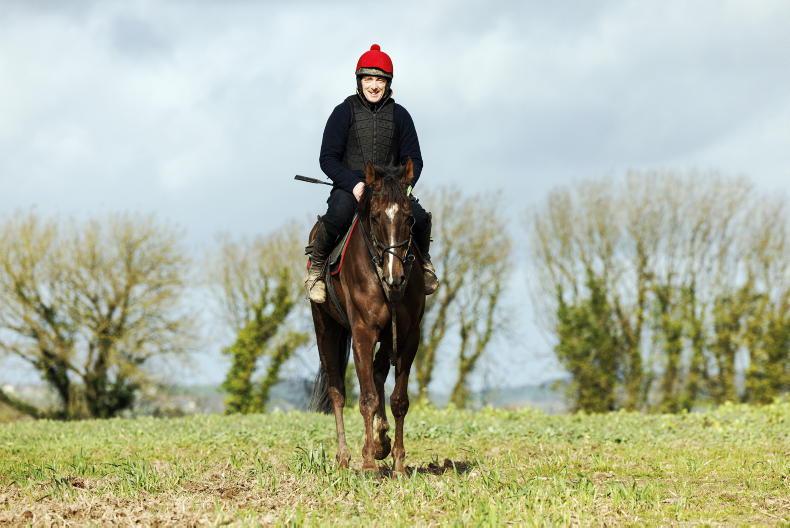
The highlight of Pat’s racing career was his 100th winner in Inch for Richie Hennessy, one of his best friends since they were kids, on The Alchemyst. \ Donal O'Leary
The move into cattle was supported by Pat qualifying for a young farmer grant for a shed but again he started small with 25 dairy-beef calves, building it up to buying 250 in 2022.
Organic? I ask.
“No,” he replies.
Have you looked at the programmes? I ask.
“No,” he replies.
Any interest? I ask.
Unsurprisingly, “No,” he replies.
I press him as to his reasoning for the definitive “no”, his response echoing the sentiments of many other farmers. “People are not willing to pay a premium for organic and it’s not viable to keep producing under the cost of production, so you can’t produce it,” he says.
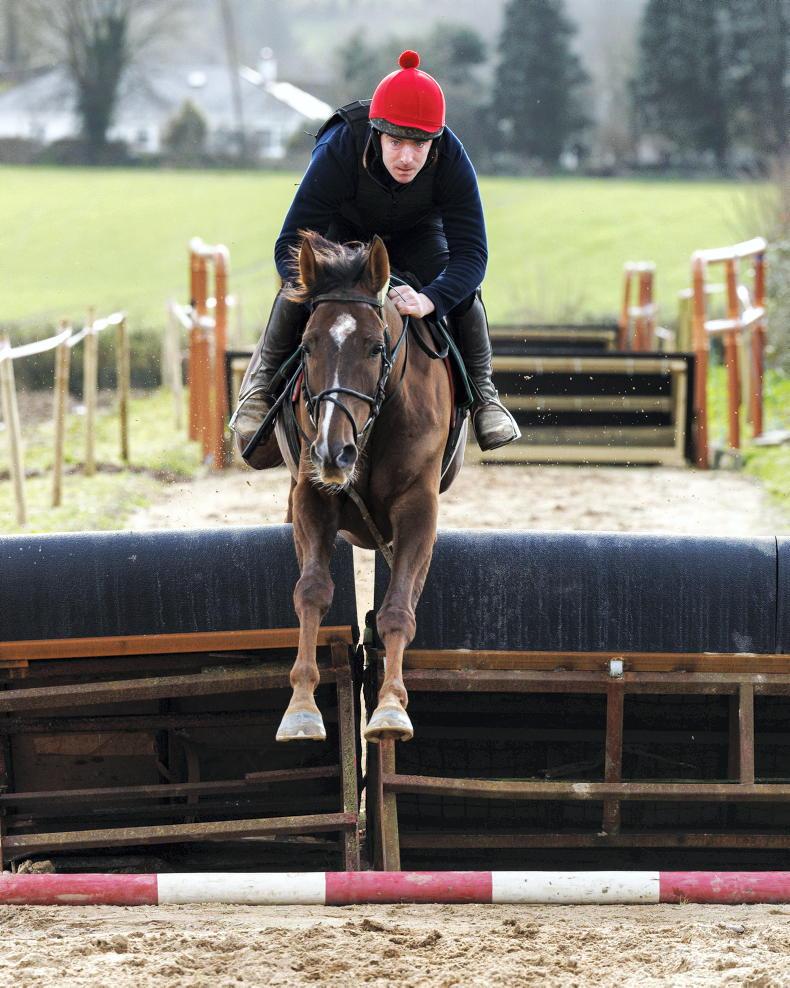
I've broken nearly every bone in my body but would I do it again? Yeah, I think I would, yeah, absolutely”. \ Donal O'Leary
He may be sceptical of the profit from organic, but is adamant that there is an income in dairy calf-to-beef production provided stocking rate and efficiency are watched.
The week of this interview, Minister of State at Department of Agriculture Food and the Marine Pippa Hackett commented that a growth in the number of part-time farmers would be a positive development. This, to Pat, is where the economics starts to become less realistic.
“If you want to make a full-time living out of something you have to put a certain amount of hours into it. If you work two hours in the morning and two hours in the evening, five days a week, that’s only 20 hours of work – that’s half a week. It’s like working part time at anything, you are not going to have a full-time wage if you work part time.”

Pat Collins, Dower, Castlemartyr, Co Cork. \ Donal O'Leary
However, when dairy calf-to-beef farming is done well, part time is profitable but Pat says the stocking rate is the key to this success.
“If you’re running 300 calves over 300ac, you’re not going to be profitable. If you have 30ac and 120 calves, you’d be very profitable.”
Always learning
Pat won the Teagasc (non-suckling) grassland farmer of the year in 2020 and this success paved the way for him in terms of his next career move.
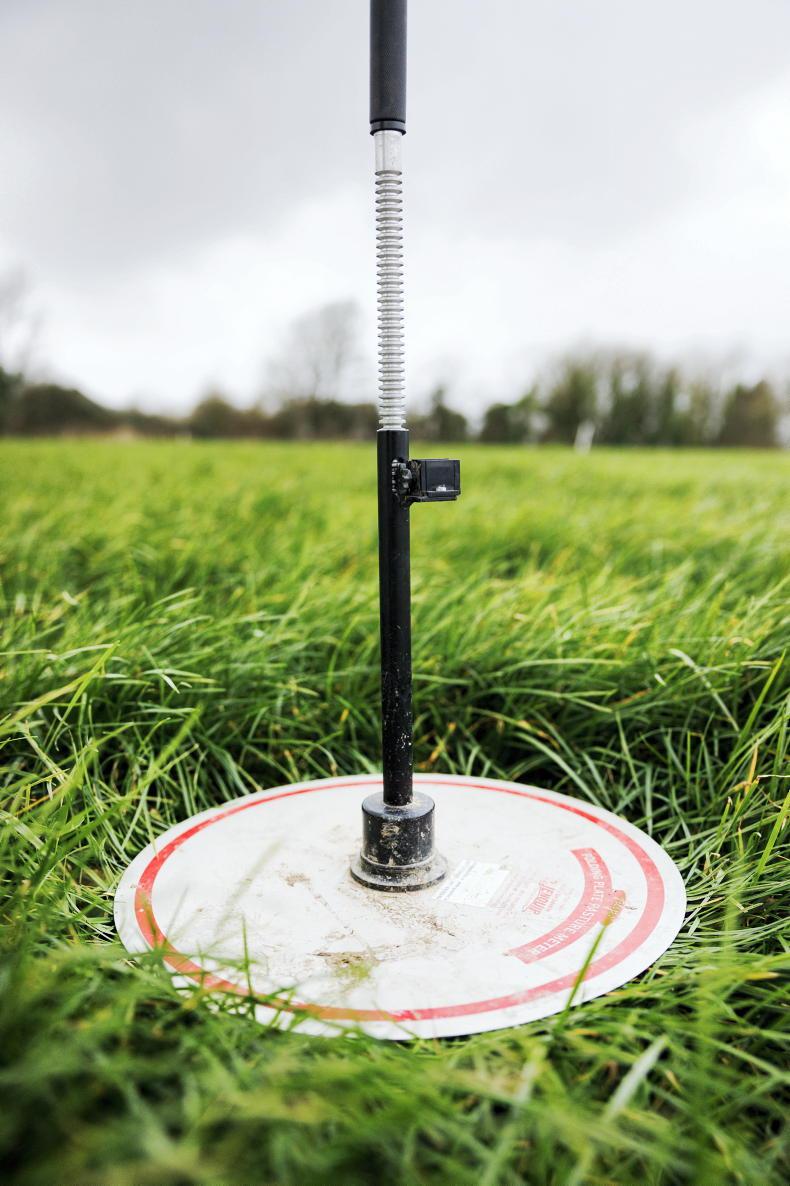
Pat believes that every farmer who is grazing grass should be measuring grass to some extent. \ Donal O'Leary
“Teagasc has all your figures on PastureBase so I entered the competition. I’m fierce interested to learn and I hate standing still.”
Driving home after his win, Pat thought to himself: “Maybe I will start a grass measuring business next year.” By the time he got home and had a shower, he told his family: “I am starting a grass measuring business.” This company is Precision Pastures.
The majority of people who employ Pat to measure, he says, “would love to be doing it themselves but they don’t have time”.
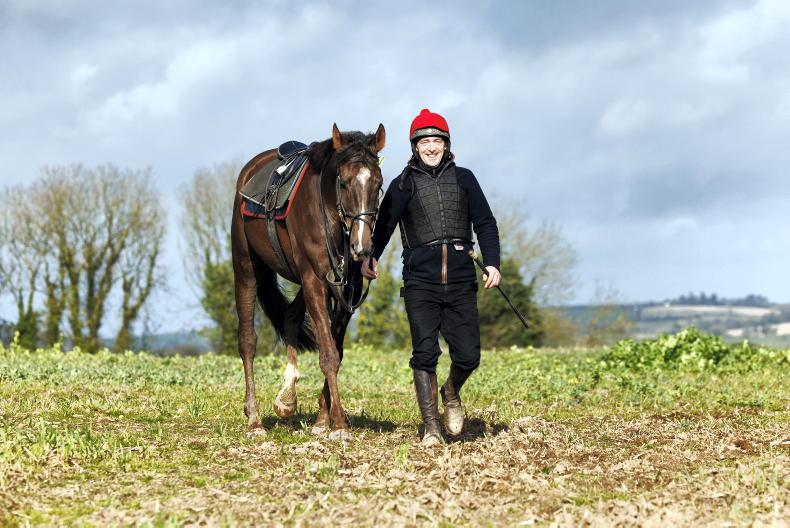
Pat Collins, Dower, Castlemartyr, Co Cork. \ Donal O'Leary
“I come in, I walk the farm every week and as I am doing a lot of it, I’m efficient, so relative to having another full- or part-time employee, it’s a small cost to the farmer.
“With the new derogation rules, more people are getting into it. However, most of the people I started with weren’t until I approached them about it but then they got going and are still doing it. They see it as a useful tool for their business. I don’t ram it down their throat, I give them the numbers, I put it up on PastureBase and I send them the report at the end of every walk.”
Demand for grass measuring services
According to Pat, new-entrant dairy farmers who are really at the cutting edge of technology are doing it themselves. He is working with mainly older dairy farmers – this is telling in itself, a beef farmer without any of his own cohort on his books.
The reason? It’s not location.
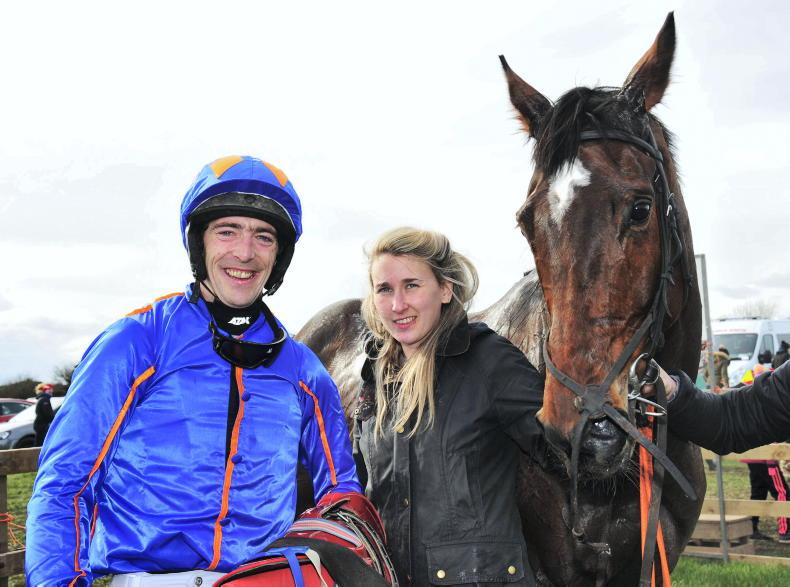
Pat Collins with his girlfriend Paula O'Brien after riding his 100th Point to Point winner. \ Healy Racing
“You take Rhidian Glyn, the Welsh hill farmer. He’s measuring grass on the side of mountains and running hundreds of cattle and sheep. I suppose some beef farmers are part time and then it’s not as important to make money out of beef,” says Pat.
He is quick to point out that this is not “all”, explaining he is in a very good beef grass measuring group with an age demographic from 80 down to 25. Of the octogenarian, Pat notes: “He only started doing it last year and regrets he didn’t start years ago”.
“So it’s a mindset. It’s easy for me to say that I think every farmer who is grazing grass should be measuring grass to some extent. It’s our biggest asset in Ireland and it’s neglected in a lot of places.”
He continues: “Fellas say to me: ‘Why are you saying that there is money in beef?’ Well I don’t want to be part of a minority, who wants to be part of a minority?
“If you go into a bank looking for money to put up a slatted shed, they’ll laugh you out the door. But if you go into a bank looking for money for a milking parlour they’ll give you double what you ask for. So if I go in with a business plan and say, ‘Here are the figures’, they’ll give it to me no problem.”
Work-life balance
All aspects of the Collins’s business employs staff. This works due to the nature of the workload, Pat explains.
“The horses are very time consuming during the winter and everything is very time consuming early in the spring. Things start to get quieter in April and that’s when the grass starts to get busy. So I can juggle things around a fair bit. That is also why I have staff so I can always push it off [the workload].
“One of the girls doing the grass measuring rides out the horses as well so I don’t have to find work for her in the winter.”
Concluding, Pat notes how, from a risk management point of view, the evolution of his business provides an element of shielding.
“There is no risk in the grass measuring because there’s no input, you are paid to do a service. The horses are high risk, beef is high risk and high return, then the tillage is low everything, but they all sort of balance each other,” he says. CL
Contact
You can contact Pat on 086-177 2623 or on Twitter @patcoll11890093
Nuffield
The most recent addition to Pat’s activities is a Nuffield Scholarship, his topic focussing on, not surprisingly The benefits of integrating dairy beef and tillage.
Of the experience so far Pat said, “I was in England in January and couldn’t get over how willing farmers were to give me time, like everyone gave me half a day – everyone. It was unbelievable. I got onto one fella on Twitter; he does tillage and has a feedlot. He put me onto a fella then that works with him and he set up the whole week for me, got me around all these farms and everyone I met nearly put me onto someone else.”
After the Contemporary Scholars Conference (now passed), Pat intends to knuckle down for the summer before travelling to New Zealand in November, then the US or Canada.
Read more
Biodiversity: Creating a sanctuary in a haven
Farmers warned about under-insuring
As well as the farm, the grass and the horses, you have to throw a couple of discussion groups, an on-going Nuffield scholarship, participation in the Signpost Programme and family life with wife Paula and daughter Harriet (18 months) – plus an arrival due this summer – into Pat Collins’s diary. Sure, it would be awful to be idle.
In partnership with his father Matt in Castlemartyr, east Cork, Pat is farming 600ac, two thirds in tillage and one third in beef with 60% rented. The Collins’s aim is to grow the majority – if not all – of the feed stuff for their beef enterprise.
“We only buy in protein and we’re looking to improve on that in the future, but at the moment, there isn’t really a viable option,” he says.

Pat completed his race riding career with a tally of 120 point-to-point winners and 20 race winners. \ Donal O'Leary
But before buying his first sheep (more of that later) Pat went to the Racing Academy and Centre of Excellence (RACE) in the Curragh. This year-long jockey training course set him on the path to a successful race riding career, starting first with Tom Taaffe.
After two years there, at 20 years of age and over 6ft tall, Pat admits that the weight was getting the better of him and so he instead concentrated on point-to-points, basing himself at home, before going to Kildalton at the age of 22 to do his green cert.
“I was 6ft 1ins and 11 stone at my lightest every morning, so I was never going to make a long-term living out of riding horses and I always wanted to go farming,” reflects Pat.
Ironically it was when he was in Kildalton that the riding really took off for him when he fell in with local trainer Eoin Doyle.

The move into cattle was supported by Pat qualifying for a young farmer grant for a shed.
“I would ride out there before college and ended up riding a load of winners for him and in turn started getting more opportunities.”
Pat completed his race riding career with a tally of 120 point-to-point winners and 20 race winners, so what was the career highlight?
“Well, I rode in Cheltenham, but probably the highlight was my 100th winner in Inch for Richie Hennessy, one of my best friends since we were kids, on The Alchemyst.”
Final straw
So why retire when successful?
“I broke a vertebrae for the second time in Boulta. I was lying on the ground and thought: ‘I’m not doing this anymore.’ Now I wouldn’t say the writing was on the wall but I was getting sick of it. I was still riding winners, my second-last ride was a winner and I’d say it was the best ride I ever gave a horse.”
Summing up the career of a jockey, Pat says: “Well, I’ve had the best days,” before stalling to clarify: “Well before I got married – to be politically correct – and had Harriet, the best days I ever had were riding.”
He pauses again before adding: “And the worst days I’ve had were riding. I’ve broken nearly every bone in my body but would I do it again? Yeah, I think I would. Yeah, absolutely.”
The farm business
Before Pat bought his first sheep, they were a fully tillage operation.
“I bought 100 sheep for the winter, fattened them on my father’s ground and the following year I got 200, then 300, then 600, then 1,000. And then I got out of sheep.”

The highlight of Pat’s racing career was his 100th winner in Inch for Richie Hennessy, one of his best friends since they were kids, on The Alchemyst. \ Donal O'Leary
The move into cattle was supported by Pat qualifying for a young farmer grant for a shed but again he started small with 25 dairy-beef calves, building it up to buying 250 in 2022.
Organic? I ask.
“No,” he replies.
Have you looked at the programmes? I ask.
“No,” he replies.
Any interest? I ask.
Unsurprisingly, “No,” he replies.
I press him as to his reasoning for the definitive “no”, his response echoing the sentiments of many other farmers. “People are not willing to pay a premium for organic and it’s not viable to keep producing under the cost of production, so you can’t produce it,” he says.

I've broken nearly every bone in my body but would I do it again? Yeah, I think I would, yeah, absolutely”. \ Donal O'Leary
He may be sceptical of the profit from organic, but is adamant that there is an income in dairy calf-to-beef production provided stocking rate and efficiency are watched.
The week of this interview, Minister of State at Department of Agriculture Food and the Marine Pippa Hackett commented that a growth in the number of part-time farmers would be a positive development. This, to Pat, is where the economics starts to become less realistic.
“If you want to make a full-time living out of something you have to put a certain amount of hours into it. If you work two hours in the morning and two hours in the evening, five days a week, that’s only 20 hours of work – that’s half a week. It’s like working part time at anything, you are not going to have a full-time wage if you work part time.”

Pat Collins, Dower, Castlemartyr, Co Cork. \ Donal O'Leary
However, when dairy calf-to-beef farming is done well, part time is profitable but Pat says the stocking rate is the key to this success.
“If you’re running 300 calves over 300ac, you’re not going to be profitable. If you have 30ac and 120 calves, you’d be very profitable.”
Always learning
Pat won the Teagasc (non-suckling) grassland farmer of the year in 2020 and this success paved the way for him in terms of his next career move.

Pat believes that every farmer who is grazing grass should be measuring grass to some extent. \ Donal O'Leary
“Teagasc has all your figures on PastureBase so I entered the competition. I’m fierce interested to learn and I hate standing still.”
Driving home after his win, Pat thought to himself: “Maybe I will start a grass measuring business next year.” By the time he got home and had a shower, he told his family: “I am starting a grass measuring business.” This company is Precision Pastures.
The majority of people who employ Pat to measure, he says, “would love to be doing it themselves but they don’t have time”.

Pat Collins, Dower, Castlemartyr, Co Cork. \ Donal O'Leary
“I come in, I walk the farm every week and as I am doing a lot of it, I’m efficient, so relative to having another full- or part-time employee, it’s a small cost to the farmer.
“With the new derogation rules, more people are getting into it. However, most of the people I started with weren’t until I approached them about it but then they got going and are still doing it. They see it as a useful tool for their business. I don’t ram it down their throat, I give them the numbers, I put it up on PastureBase and I send them the report at the end of every walk.”
Demand for grass measuring services
According to Pat, new-entrant dairy farmers who are really at the cutting edge of technology are doing it themselves. He is working with mainly older dairy farmers – this is telling in itself, a beef farmer without any of his own cohort on his books.
The reason? It’s not location.

Pat Collins with his girlfriend Paula O'Brien after riding his 100th Point to Point winner. \ Healy Racing
“You take Rhidian Glyn, the Welsh hill farmer. He’s measuring grass on the side of mountains and running hundreds of cattle and sheep. I suppose some beef farmers are part time and then it’s not as important to make money out of beef,” says Pat.
He is quick to point out that this is not “all”, explaining he is in a very good beef grass measuring group with an age demographic from 80 down to 25. Of the octogenarian, Pat notes: “He only started doing it last year and regrets he didn’t start years ago”.
“So it’s a mindset. It’s easy for me to say that I think every farmer who is grazing grass should be measuring grass to some extent. It’s our biggest asset in Ireland and it’s neglected in a lot of places.”
He continues: “Fellas say to me: ‘Why are you saying that there is money in beef?’ Well I don’t want to be part of a minority, who wants to be part of a minority?
“If you go into a bank looking for money to put up a slatted shed, they’ll laugh you out the door. But if you go into a bank looking for money for a milking parlour they’ll give you double what you ask for. So if I go in with a business plan and say, ‘Here are the figures’, they’ll give it to me no problem.”
Work-life balance
All aspects of the Collins’s business employs staff. This works due to the nature of the workload, Pat explains.
“The horses are very time consuming during the winter and everything is very time consuming early in the spring. Things start to get quieter in April and that’s when the grass starts to get busy. So I can juggle things around a fair bit. That is also why I have staff so I can always push it off [the workload].
“One of the girls doing the grass measuring rides out the horses as well so I don’t have to find work for her in the winter.”
Concluding, Pat notes how, from a risk management point of view, the evolution of his business provides an element of shielding.
“There is no risk in the grass measuring because there’s no input, you are paid to do a service. The horses are high risk, beef is high risk and high return, then the tillage is low everything, but they all sort of balance each other,” he says. CL
Contact
You can contact Pat on 086-177 2623 or on Twitter @patcoll11890093
Nuffield
The most recent addition to Pat’s activities is a Nuffield Scholarship, his topic focussing on, not surprisingly The benefits of integrating dairy beef and tillage.
Of the experience so far Pat said, “I was in England in January and couldn’t get over how willing farmers were to give me time, like everyone gave me half a day – everyone. It was unbelievable. I got onto one fella on Twitter; he does tillage and has a feedlot. He put me onto a fella then that works with him and he set up the whole week for me, got me around all these farms and everyone I met nearly put me onto someone else.”
After the Contemporary Scholars Conference (now passed), Pat intends to knuckle down for the summer before travelling to New Zealand in November, then the US or Canada.
Read more
Biodiversity: Creating a sanctuary in a haven
Farmers warned about under-insuring














 This is a subscriber-only article
This is a subscriber-only article











SHARING OPTIONS: